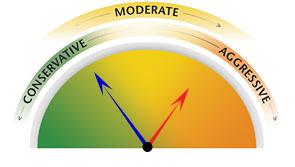
Close window
Portfolio Risk Management (PRM)
|
Click on a subject below for more information about Portfolio Risk Management.
Portfolio Risk Management (PRM) is a tool designed to help you assess and manage the level of risk in your portfolio, so that you can stay on track to your retirement savings goals. All investments carry a certain level of risk, which varies among the different categories of funds. And just as funds have different risk profiles, so do investors – you may be comfortable with:
The Investor Profiler in the Plan your financial future section lets you determine your comfort level for risk, and suggests the categories of funds you should invest in and the percentage to allocate to each category. Once you know your comfort level, you can choose one of the suggested investment mixes, or create your own Investment Mix from the funds available. The level of risk of your Investment Mix should be in line with your Investor Profile – this is where PRM comes in.
One of the main features of PRM is the R-meter; it shows the level of risk of your investment instructions for future deposits (Investment Mix) and the level of risk of your current holdings (Asset Mix), at a plan level and at an account level. Your Asset Mix will change with market fluctuations, but your Investment Mix should be changed gradually over the long term as you get closer to retirement. If the risk measurements for the asset and investment mixes deviate significantly from each other, you may wish to take corrective action by rebalancing your assets or changing your investment instructions. 

The levels of risk displayed on the R-meter are determined by calculating a weighted average of the risk rating for the funds in an Investment or Asset Mix. Therefore, if a relatively high-risk fund makes up a very large proportion (or weight) of an Investment Mix, this will cause the level of risk for the mix to be higher than if there was a heavy weight in low or medium-risk funds.
If a mix is overly conservative, there is a possibility that you may not accumulate enough assets over the long term to reach your retirement savings goals. If a mix is overly aggressive, this means that too much of your current holdings and/or your future deposits are being invested in high-risk funds, for which you should expect your returns to be more volatile than average. Why is it important to minimise the deviation between levels of risk for the Investment Mix and the Asset Mix? Over time your Asset Mix may drift from your Investment Mix due to market fluctuations, which may cause a deviation in their respective levels of risk. It is important to minimise this deviation because your Investment Mix is intended to maintain your assets in line with your comfort level for risk.
If you notice a deviation between levels of risk of the Asset Mix and Investment Mix, you may be content to leave your mixes as-is, or you may wish to:
Yes, but your assets will be rebalanced according to the latest instructions received. For example, if you rebalance your assets then change the investment instructions for that account later that same day, your assets will be rebalanced according to the newer instructions.
Click this link to read about asset rebalancing.
You can view levels of risk for the Asset Mix and Investment Mix at plan level and at account level, however changes are made at the account level.
You can use PRM with most accounts under registered plans for which you have investment mix discretion (i.e. those for which you, not your employer, choose the investment funds and allocation).
Manulife’s Financial Education Centre, found in the Plan your financial future section, contains information about the different asset categories, as well as over 20 other modules on retirement, financial and life-cycle planning. A list of funds available under your plan, as well as performance data for each fund, can be found by clicking Rates and closing values in the Consult investment performance section.
N.B.: Please note that the levels of risk shown using the Portfolio Risk Management feature relate solely to assets within your Manulife Group Savings & Retirement plan(s). You should consider the level of risk of your overall portfolio, including other investment holdings, when making investment decisions. Our Member Services representatives are available at 1 800 242-1704 to provide guidance and answer any questions with regards to your group savings and retirement plan(s). |
 Legal and privacy statement | © 2017 Manulife. All rights reserved.
Legal and privacy statement | © 2017 Manulife. All rights reserved.
